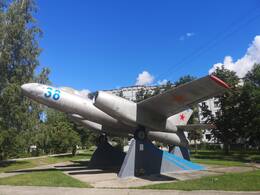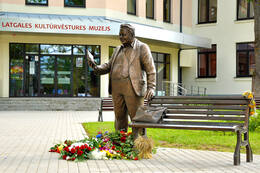Bombing of Rezekne in 1944
The bombing of Rēzekne took place on Easter 1944, and as a result, a large part of the city's buildings were destroyed and dozens of civilians were killed, while thousands more were left homeless. The people who experienced these events firsthand and can tell us about them were only children at the time. The author of this story is one of them.
It was around Easter. We lived in Rēzekne, near the lake. Russian planes, bombers flew quite high and dropped leaflets that the city would be bombed and the residents should evacuate. In turn, German fighters could not fly higher and shoot at those bombers. That first night there was no bombing, and then we went out into the countryside, towards Malta, to escape. However, there was no bombing and we returned back. The next day the same thing happened again with the leaflets, but we no longer believed it, we did not leave and stayed. The next day they dropped leaflets again, the fighters were shooting there and again we pretended not to believe it and stayed. Mother had gone somewhere, there was only father and us children in the house. Father sat and listened to the radio the whole time. The first bombs exploded at night further from us, then exploded in the lake, where people also died, and then one bomb exploded at one end of our house, and it completely destroyed half of the building. Of course, my father ran to see what was happening to the children, but they were all sleeping, I was the eldest, but there were 2 more sisters and a brother, who was the youngest, born only in 1941, very small. We all escaped through the window, because the door was boarded up and we couldn't get out, then the neighbors helped my father get us all out through the windows, and there was a basement in the yard, where we took refuge. Those rockets had already been thrown a lot and we could see the devastation from our yard, the whole city was bombed very hard. After that, we never returned to our house or lived there. Sometime later, we went to see, and everything there had been completely transformed. At first, after the bombing, we moved very close to distant relatives, who had half of their house freed up, because their daughter had fled to America with her husband as a refugee. After that incident, my father and other men were already preparing a bunker for themselves in the forest, in case someone came again, so they could hide there. Later, when the Germans retreated, there was an incident when a German came to us, he had a hand grenade in his hand, and demanded to be given food, the landlady who housed us gave us chickens, eggs, and other goodies. Then after that, the Russians came in, who also settled in our yard, and since there were many women there, they treated all of us little ones to chocolate. But they didn't last long either.
Related timeline
Related objects
Skulte airplane IL-28
Located in the village of Skulte in Mārupe municipality, near Riga International Airport.
Skulte was one of the model villages created for Soviet military personnel. An aviation unit was located there, which carried out the bombing of Berlin and other cities in 1941, and also participated in the occupation of the Baltic States. In 1978, an environmental object - an IL-28 aircraft - was installed there to highlight the merits of Soviet Army pilots in World War II.
After the war, the Soviet Union continued its active armament policy. The IL-28 was the first, most widely produced Soviet jet bomber. The first serial atomic bomb, the RDS-4 ("Tatyana"), was dropped from the same model in 1953 to test the army's ability to launch an attack after a nuclear explosion. The aircraft had various modifications. During tests, it reached a speed of 906 km/h, carrying several tons of cargo and making a flight of 2,445 km. It was piloted by a crew of 3 people.
The plane is not only a witness to military heritage, but also a symbol of ideology. In 2010, to celebrate the victory of the Soviet Army over Germany, the plane was restored. There have also been several unsuccessful attempts to dismantle it as an object glorifying the Latvian occupation regime. This was successful in 2022, when the plane was moved.
Currently, the aircraft can be viewed nearby at the Riga Aviation Museum in Skulte, as well as get an idea of the village built for Soviet Army military personnel.
Museum of the Occupation of Latvia
The museum exhibits the history of Latvia from 1940 to 1991, under the occupation of Nazi Germany and the Soviet Union. ‘House of the Future’ is a reconstruction and expansion project of the Occupation Museum designed by the well-known American Latvian architect Gunārs Birkerts as well as the new exhibit of the museum. The exhibit ‘History of Cheka in Latvia’ was created by the Occupation Museum and it is located in the ‘Corner House’, which is the former USSR State Security Committee (KGB) building. Latvian Occupation Museum was founded in 1993. It tells the long-hidden story of the fate of the Latvian state, nation and land under the occupation of two foreign totalitarian powers from 1940 to 1991. At the end of 2020 the museum had more than 70,000 different historical items (documents, photographs, written, oral and material evidence, objects and memorabilia). Museum specialists have recorded more than 2,400 video testimonials, making it one of the largest collections on occupation in Europe. The events that unfolded in Latvia, Lithuania and Estonia clearly show us what the nations had to endure under the two totalitarian regimes.
Latgale Culture and History Museum
Three permanent exhibitions are on display at the Latgale Culture and History Museum in Rēzekne. One of them – “Rēzekne laikmetu griežos” (Rēzekne through Ages) – tells the story of the history of the city over seven centuries. A significant part of it is devoted to the events, wars and changes of the 20th century: World War I, the War of In dependence, World War II, the destruction of Rēzekne in 1944 by the Soviet bombers, as well as the prisoner-of-war camp Stalag 347. The exhibition includes a photo booth about the fates of the soldiers from Rēzekne during the war.
During the period of the free state of Latvia, the soldiers of the 9th Rēzekne Infantry Regiment of the Latvian Army stationed in Rēzekne were an integral part of the public life of the city and sporting events, especially during the celebrations of the 11th and 18th of November.







